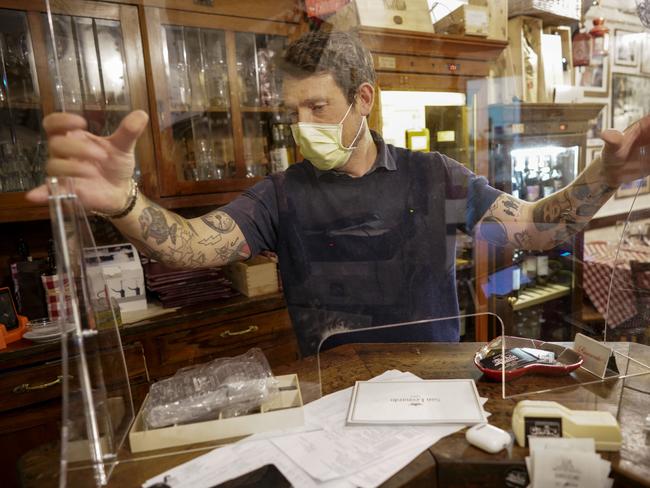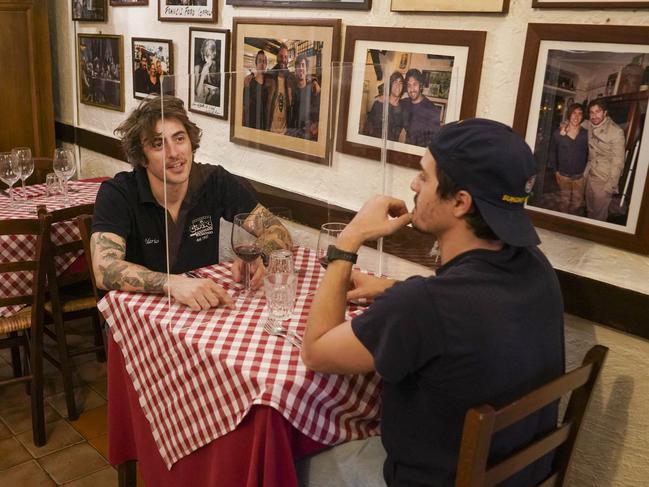UK lockdown: How Europe is trying to get back to normal after COVID-19
There is no doubt that even when Europe comes out of lockdown, it will not be back to normal. The UK is in it for the long haul — even with these band aid solutions.
Coronavirus
Don't miss out on the headlines from Coronavirus. Followed categories will be added to My News.
Plastic dividers are being touted as the social distancing solution to get restaurants open across Europe to beat coronavirus.
Already in Rome, which is a few weeks ahead of the UK on the infection curve, restaurants have bought up big to trial the new separators.
The idea being that the plexiglass will stop coronavirus droplets being swapped between diners.
But the attempt to kill the bug will also kill the mood.
Even if anyone has money in their pockets to go out for a meal, it just will not be the same.
And many of the best cheap and cheerful restaurants who rely on making good food at cheap prices will also be victims.
Those restaurants that rely on turning over tables might lose more money opening than staying closed.
There is no doubt that even when Europe comes out of lockdown, it will not be back to normal, despite the band aid plexiglass solutions.
It has become clear this week in the UK that we are in for the long haul.
There are debates about when and how to ease restrictions and Sophie’s Choice sums about the cost of lives lost to coronavirus versus the lives lost to patients missing out on cancer diagnosis.

Prime Minister Boris Johnson was said to be leaning towards keeping restrictions in place for as long as possible.
He knows first hand how bad it is to get coronavirus from his own time in the intensive care unit at St Thomas’ Hospital in London.
The main problem in the UK has been the disgraceful lack of testing and refusal to engage the private sector quickly.
The socialist style National Health Service is full of amazing doctors and nurses. I don’t share the same enthusiasm for their meddling middle managers.
Up to 7 million key workers and their families will now be allowed to access coronavirus testing after restrictions were eased this week.
But they still have to get to a testing station, which some claim will take them hours on a round trip.
MORE NEWS
COVID-19 death toll climbs as Aussies ignore social distancing
COVID-19 restrictions: The Aussie pub fight
School shutdown ‘will further entrench poverty’

And that’s only for those who have coronavirus now.
Antibody testing for those who believe they had the virus but have recovered is not being offered, making it almost impossible to get everything moving again.
The procurement of protective equipment for nurses and doctors has been disgraceful, with mixed messages about when it was going to be delivered.
For at least the rest of the year, the world will look very different.
It’s not official yet but masks will likely become recommended, with makeshift masks from bandanas and scarves likely to do the trick.
Hairdressers will not open for at least six months, according to reports this week.
Some of the television presenters are already looking a bit scruffy so it will be interesting to see how their home hair cuts go.
There are signs that the lockdown is starting to lose its shine, with traffic increasing on the roads with people desperate to get back to work.
Others are lining up at Bunnings equivalent B and Q to fix up their house while they’re twiddling their thumbs.
Elisa Granato, who was one of the first to be injected with a promising Oxford University vaccine this week, is one of the few productive people in the whole country.
Along with 800 others, the results of her vaccine trial may be the only way we can get back to a restaurant without having a plexiglass divider sharing the meal.

